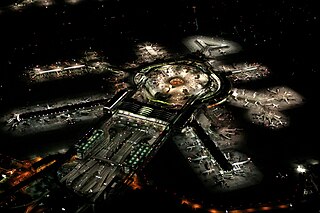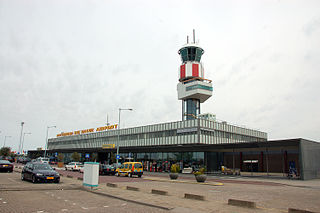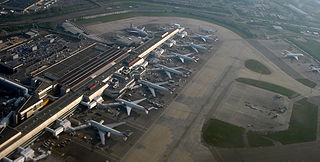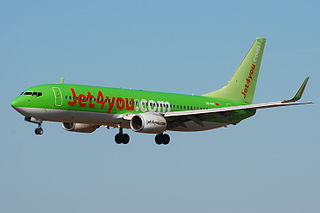
An airline is a company that provides air transport services for traveling passengers and/or freight. Airlines use aircraft to supply these services and may form partnerships or alliances with other airlines for codeshare agreements, in which they both offer and operate the same flight. Generally, airline companies are recognized with an air operating certificate or license issued by a governmental aviation body. Airlines may be scheduled or charter operators.

The Netherlands is both a very densely populated and a highly developed country in which transport is a key factor of the economy. Correspondingly it has a very dense and modern infrastructure, facilitating transport with road, rail, air and water networks. In its Global Competitiveness Report for 2014-2015, the World Economic Forum ranked the Dutch transport infrastructure fourth in the world.
Transportation in South Korea is provided by extensive networks of railways, highways, bus routes, ferry services and air routes that traverse the country. South Korea is the third country in the world to operate a maglev train, which is an automatically run people mover at Incheon International Airport.

Indira Gandhi International Airport is the primary international airport serving Delhi, the capital of India, and the National Capital Region (NCR). The airport, spread over an area of 5,106 acres (2,066 ha), is situated in Palam, Delhi, 15 km (9.3 mi) southwest of the New Delhi Railway Station and 16 km (9.9 mi) from New Delhi city centre. Named after Indira Gandhi (1917–1984), the former Prime Minister of India, it is the busiest airport of India in terms of passenger traffic since 2009. It is also the busiest airport in the country in terms of cargo traffic, overtaking Mumbai during late 2015. As of 2022, it is the seventh busiest airport in the world, as per the latest rankings issued by UK-based air consultancy firm, OAG. It is the second busiest airport in the world by seating capacity, having a seating capacity of over 3.6 million seats, and the busiest airport in Asia by passenger traffic handling nearly 37.14 million passengers in 2021.

Glasgow Airport, also known as Glasgow International Airport, formerly Abbotsinch Airport, is an international airport in Scotland. It is located in Paisley, Renfrewshire, 8.6 nautical miles west of Glasgow city centre. In 2019, the airport handled 8.84 million passengers, an 8.4% annual decrease, making it the second-busiest in Scotland, after Edinburgh Airport, and the ninth-busiest airport in the United Kingdom.

Gold Coast Airport is an international Australian airport located at the southern end of the Gold Coast and approximately 90 km (56 mi) south of centre of Brisbane, within South East Queensland agglomeration. The entrance to the airport is situated in the suburb of Bilinga near Coolangatta. The runway itself cuts through the state borders of Queensland and New South Wales. During summer, these states are in two different time zones. The Gold Coast Airport operates on Queensland Time all year round.

Hiroshima Airport is an airport in the city of Mihara, Hiroshima Prefecture, Japan. Located 50 km (31 mi) east of Hiroshima, it is the largest airport in the Chūgoku region.
Air Astana is an airline group based in Almaty, Kazakhstan. It operates scheduled international and domestic services on 64 routes from its main hub, Almaty International Airport, and from its secondary hub, Nursultan Nazarbayev International Airport. It is a joint venture between Kazakhstan's sovereign wealth fund Samruk-Kazyna (51%), and BAE Systems PLC (49%). It was incorporated in October 2001 and started commercial flights on 15 May 2002. It is one of a small number of airlines which has required neither government subsidy nor shareholder financial support to overcome the effects of the COVID-19 pandemic, thus preserving its central corporate principle of financial, managerial and operational independence.

An international airport is an airport with customs and border control facilities enabling passengers to travel between countries around the world. International airports are usually larger than domestic airports and they must feature longer runways and have facilities to accommodate the heavier aircraft such as the Boeing 747 commonly used for international and intercontinental travel. International airports often also host domestic flights, which often help feed both passengers and cargo into international ones.
Economy class, also called third class, coach class, steerage, or to distinguish it from the slightly more expensive premium economy class, standard economy class or budget economy class, is the lowest travel class of seating in air travel, rail travel, and sometimes ferry or maritime travel. Historically, this travel class has been called tourist class or third class on ocean liners.

Rotterdam The Hague Airport, is a minor international airport serving Rotterdam, the Netherlands' second largest city, and The Hague, its administrative and royal capital. It is located 3 NM north northwest of Rotterdam in South Holland and is the third busiest airport in the Netherlands.

Like other emissions resulting from fossil fuel combustion, aircraft engines produce gases, noise, and particulates, raising environmental concerns over their global effects and their effects on local air quality. Jet airliners contribute to climate change by emitting carbon dioxide, the best understood greenhouse gas, and, with less scientific understanding, nitrogen oxides, contrails and particulates. Their radiative forcing is estimated at 1.3–1.4 that of CO2 alone, excluding induced cirrus cloud with a very low level of scientific understanding. In 2018, global commercial operations generated 2.4% of all CO2 emissions.

Air transport in the United Kingdom is the commercial carriage of passengers, freight and mail by aircraft, both within the United Kingdom (UK) and between the UK and the rest of the world. In the past 25 years the industry has seen continuous growth, and the demand for passenger air travel in particular is forecast to increase from the current level of 236 million passengers to 465 million in 2030. One airport, Heathrow Airport, is amongst the top ten busiest airports in the world. More than half of all passengers travelling by air in the UK currently travel via the six London area airports. Outside London, Manchester Airport is by far the largest and busiest of the remaining airports, acting as a hub for the 20 million or so people who live within a two-hour drive. Regional airports have experienced the most growth in recent years, due to the success of low-cost carrier airlines over the last decade.
The United States has an extensive air transportation network. In 2013, there were 86 airports in the U.S. that annually handled over 1,000,000 passengers each and eight of the world's thirty busiest airports by passenger volume in 2020 were in the U.S., including the world's second busiest, Hartsfield-Jackson Atlanta International Airport. In 2012, 88% of all traffic was through the 62 busiest airports in the country. In terms of cargo, in 2015, eight of the world's thirty busiest airports were in the U.S., including the world's second busiest, Memphis International Airport, behind only Hong Kong International Airport in China. Private aircraft are also used for medical emergencies, government agencies, large businesses, and individuals, see general aviation.

Aviation in Indonesia serves as a critical means of connecting the thousands of islands throughout the archipelago. Indonesia is the largest archipelagic country in the world, extending 5,120 kilometres (3,181 mi) from east to west and 1,760 kilometres (1,094 mi) from north to south, comprising 13,466 islands, with 922 of those permanently inhabited. With an estimated population of over 255 million people — making it the world's fourth-most-populous country — and also due to the growth of the middle-class, the boom of low-cost carriers in the recent decade, and overall economic growth, many domestic travellers shifted from land and sea transport to faster and more comfortable air travel. Indonesia is widely regarded as an emerging market for air travel in the region. Between 2009 and 2014, the number of Indonesian air passengers increased from 27,421,235 to 94,504,086, an increase of over threefold.

Aviation taxation and subsidies includes taxes and subsidies related to aviation.

The COVID-19 pandemic has had a significant impact on the airline industry due to travel restrictions and a decimation in demand among travelers.
The kerosene tax is an ecotax on the kerosene-based jet fuel in commercial aviation, which can be levied within and by the European Union. The legal basis for it is the Energy Taxation Directive (2003/96/EG) of 27 October 2003, which proves the member states with the option of introducing a tax on turbine fuel for commercial domestic flights and flights between member states.

A short-haul flight ban is a prohibition imposed by governments on airlines to establish and maintain a flight connection over a certain distance, or by organisations or companies on their employees for business travel using existing flight connections over a certain distance, in order to mitigate the environmental impact of aviation. In the 21st century, several governments, organisations and companies have imposed restrictions and even prohibitions on short-haul flights, stimulating or pressuring travellers to opt for more environmentally friendly means of transportation, especially trains.














